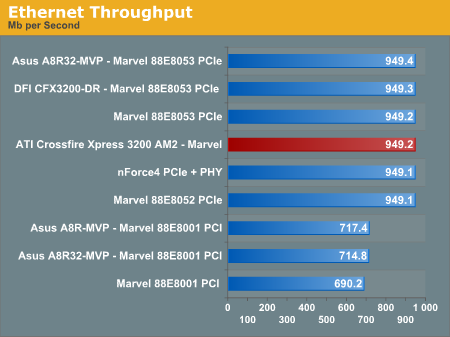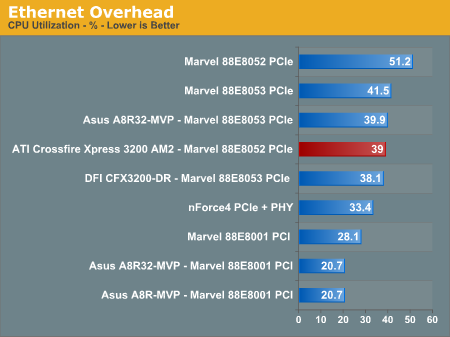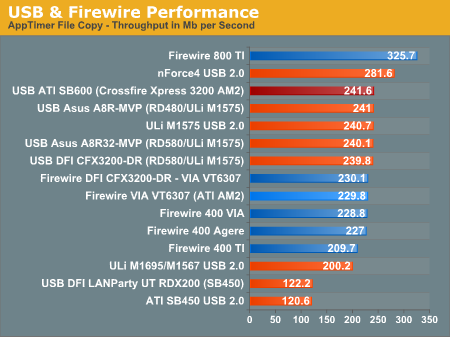CrossFire Xpress 3200: RD580 for AM2
by Wesley Fink on June 1, 2006 12:05 AM EST- Posted in
- Motherboards
Network
The Windows 2000 Driver Development Kit (DDK) includes a useful LAN testing utility called NTttcp. We used the NTttcp tool to test Ethernet throughput and the CPU utilization of the various Ethernet Controllers used on the AMD motherboards.
We set up one machine as the server; in this case, an Intel box with an Intel CSA Gigabit LAN connection. Intel CSA has a reputation for providing fast throughput and this seemed a reasonable choice to serve our Gigabit LAN clients. At the server side, we used the following Command Line as suggested by the VIA whitepaper on LAN testing:
On the client side (the motherboard under test), we used the following Command Line:
At the conclusion of the test, we captured the throughput and CPU utilization figures from the client screen.


The PCIe Gigabit LAN on the ATI is capable of about 35% faster speed than the performance we have measured with PCI Gigabit LAN used on some motherboards. ATI provides a single Marvell PCIe Gigabit controller, compared to dual Gigabit LAN on the competing NVIDIA 590 chipset. All of the on-board PCIe Ethernet controllers seem to exhibit high CPU utilization, but you should keep in mind that the CPU usage we measure is an extremely artificial number which measures the worst case of a continuous Gb transmission. With broad-band connections needing no more than 100Mb Ethernet, the real-world CPU usage will be much lower than these test results. Throughput and CPU utilization for the ATI AM2 were competitive with results from other boards.
USB and Firewire Performance
USB has been a problem area for the ATI SB450 chipset, but it has not been a major issue with the ULi M1575 Southbridge. To test performance of USB and Firewire on the ATI CrossFire Xpress 3200 AM2 we ran our standard USB throughput test using an external USB hard drive. For Firewire tests an external Firewire 400 or 800 hard disk is used for testing
Our test method uses a RAM disk as our "server" since memory removes almost all overhead from the serving end. We also turn off disk caching on the USB and Firewire side by setting up the drives for "quick disconnect". Our results are then consistent over many test runs.
We used 2GB of fast system memory, set up as a 450MB RAM disk and the balance as system memory. Our stock file is the SPECviewPerf 8.01 install file which is 432, 533, 504 bytes (412.4961MB). After copying this file to our RAM disk, we measure the time for writing from the RAM disk to our external USB 2.0 or Firewire 400 or Firewire 800 drive using an internally developed Windows timing program. The copy times are then converted into Megabits per second (Mb) to provide a convenient means of comparing throughput. Higher rates therefore mean better performance.

A red bar is used for SB600 USB performance and orange bars represent competing chipsets. Blue bars represent Firewire performance.
SB600 lived up to its promise, scoring in the same performance range as competing USB solutions. That is, ATI SB600 is a bit faster than the Uli M1575 in USB 2.0 performance and slightly slower than NVIDIA USB 2.0 performance. At current SB600 performance levels you should see no difference in USB 2.0 performance between NVIDIA and ATI SB600.
ATI chose the excellent VIA VT6307 for Firewire on the reference board. Firewire 400 performance is excellent compared to competing Firewire chips. Keep in mind that the manufacturer can choose whatever Firewire chip they choose to use on NVIDIA and ATI AM2 motherboards. Neither chipset includes native Firewire support.
The Windows 2000 Driver Development Kit (DDK) includes a useful LAN testing utility called NTttcp. We used the NTttcp tool to test Ethernet throughput and the CPU utilization of the various Ethernet Controllers used on the AMD motherboards.
We set up one machine as the server; in this case, an Intel box with an Intel CSA Gigabit LAN connection. Intel CSA has a reputation for providing fast throughput and this seemed a reasonable choice to serve our Gigabit LAN clients. At the server side, we used the following Command Line as suggested by the VIA whitepaper on LAN testing:
NTttcps -m 4, 0, ‹client IP› -a 4 -l 256000 -n 30000
On the client side (the motherboard under test), we used the following Command Line:
NTttcpr -m 4, 0, ‹server IP› -a 4 -l 256000 -n 30000
At the conclusion of the test, we captured the throughput and CPU utilization figures from the client screen.


The PCIe Gigabit LAN on the ATI is capable of about 35% faster speed than the performance we have measured with PCI Gigabit LAN used on some motherboards. ATI provides a single Marvell PCIe Gigabit controller, compared to dual Gigabit LAN on the competing NVIDIA 590 chipset. All of the on-board PCIe Ethernet controllers seem to exhibit high CPU utilization, but you should keep in mind that the CPU usage we measure is an extremely artificial number which measures the worst case of a continuous Gb transmission. With broad-band connections needing no more than 100Mb Ethernet, the real-world CPU usage will be much lower than these test results. Throughput and CPU utilization for the ATI AM2 were competitive with results from other boards.
USB and Firewire Performance
USB has been a problem area for the ATI SB450 chipset, but it has not been a major issue with the ULi M1575 Southbridge. To test performance of USB and Firewire on the ATI CrossFire Xpress 3200 AM2 we ran our standard USB throughput test using an external USB hard drive. For Firewire tests an external Firewire 400 or 800 hard disk is used for testing
Our test method uses a RAM disk as our "server" since memory removes almost all overhead from the serving end. We also turn off disk caching on the USB and Firewire side by setting up the drives for "quick disconnect". Our results are then consistent over many test runs.
We used 2GB of fast system memory, set up as a 450MB RAM disk and the balance as system memory. Our stock file is the SPECviewPerf 8.01 install file which is 432, 533, 504 bytes (412.4961MB). After copying this file to our RAM disk, we measure the time for writing from the RAM disk to our external USB 2.0 or Firewire 400 or Firewire 800 drive using an internally developed Windows timing program. The copy times are then converted into Megabits per second (Mb) to provide a convenient means of comparing throughput. Higher rates therefore mean better performance.

A red bar is used for SB600 USB performance and orange bars represent competing chipsets. Blue bars represent Firewire performance.
SB600 lived up to its promise, scoring in the same performance range as competing USB solutions. That is, ATI SB600 is a bit faster than the Uli M1575 in USB 2.0 performance and slightly slower than NVIDIA USB 2.0 performance. At current SB600 performance levels you should see no difference in USB 2.0 performance between NVIDIA and ATI SB600.
ATI chose the excellent VIA VT6307 for Firewire on the reference board. Firewire 400 performance is excellent compared to competing Firewire chips. Keep in mind that the manufacturer can choose whatever Firewire chip they choose to use on NVIDIA and ATI AM2 motherboards. Neither chipset includes native Firewire support.










71 Comments
View All Comments
Wesley Fink - Thursday, June 1, 2006 - link
1X Increments corrected.We did not have audio performance data for nVidia chipsets in the 590 launch review, but it will be included in our roundup of 6 AM2 boards which is in process. I have added numbers for the Foxconn ( nForce 590) HD codec for reference. Foxconn is the nVidia Reference board.
The board photo was captured at 12 Megapixels. Unfortunately, the "Save for Web" feature in Photoshop which gets the image to a reasonable file size for posting a 1280 image compromises sharpness at higher resolutions.
Trisped - Thursday, June 1, 2006 - link
Thanks for the Foxconn numbers.So you used "Save for Web" and lowered the quality so it would be easier to download? That makes sense. A 43k file is much better then a 1M one.
JarredWalton - Thursday, June 1, 2006 - link
Or 422K vs. 5+ MB. ;)lopri - Thursday, June 1, 2006 - link
I truly appreciate AT staff's responses to my questions. It cleared so many things that I questioned while reading the review, so now I'm understanding better.This is actually the only possible explanation that I could think of. You're right in that DDR400 is the fastest JEDEC approved speed. I sort of guessed but still, considering the ammount of memory reviews you've done in the past, thought a bit stranage. But thank you for explaining. Request, however: Please do a out-of-the spec DDR vs DDR2 reviews in the future. :D This can be a big factor for people who actually consider upgrading.
Again, I appreciate the explanation. Not knowing about DDR2 much myself still, I could not have known it when reading the review. It'd have cleared up some misunderstanding if you have mentioned the 1T/2T issues in the review (like above), it'd have helped a ton to understand. I'm sure there are many different traits of DDR2 compared to DDR, without such knowledge I could not help but questioning. Thank you, Gary.
Still the 1T/2T issue on AM2 is somewhat disappointing. (Not reviewers' fault) I have a bad feeling that AMD's IMC won't be able to handle 1T for DIMMs faster than DDR2-800, even with future revision. :( For entire lifespan of Socket 939, they couldn't get 4 sticks to run @1T timing.. (except a couple going-around of DFI's)
lopri - Thursday, June 1, 2006 - link
Also if this is true, it's an absolutely fantastic news. Please let us know the detail as soon as you can. Thank you.
DigitalFreak - Thursday, June 1, 2006 - link
Maybe they didn't need to develop a new North bridge, but the South bridge is another matter. With ULi supplies drying up, it would have been extremely stupid to use the SB450 yet again.
Myrandex - Thursday, June 1, 2006 - link
It was stated that the ATI solution was better tahn the ULI and less than Nvidia, however in the graphs it was less than both, although very close to ULI.Jason
Wesley Fink - Thursday, June 1, 2006 - link
The statement is correct. Going back to review notes there was a typo in the chart creation which has now been corrected. USB throughput for SB600 is 241.6 and not 231.6 as shown in the earlier chart.Alyster - Thursday, June 1, 2006 - link
I just wonder if SB600 will be available on 939 boards in future. I'm going to purchase ATI based MSI-RS482M4-ILD mATX motherboard with SB450 and may be I should wait untill they start offering SB600 on mATX boards. Any suggestions? ThanksWesley Fink - Thursday, June 1, 2006 - link
As we understand it, SB600 is not pin-compatible with SB450, so it is not a drop-in for the older chip. We therefore think it is unlikely you should wait for a board redesign on an older 939 board. Any new 939 boards - and there may be some if the market wants them - will likely use SB600.